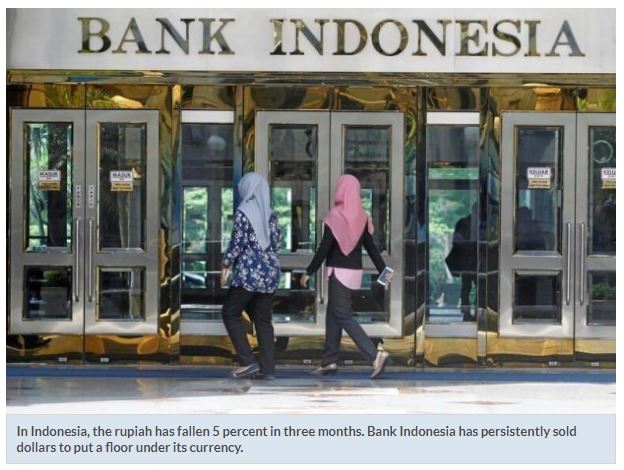As currencies weaken, Asia’s central bankers go for classic defence
SINGAPORE: To deal with a familiar combination of falling currencies and uncertainty about economic growth, Asian central banks are reverting to their classic policy playbook. They are intervening in currency markets while concurrently injecting cash into their economies.
The currencies of Asia’s economies with relatively high interest rates, such as Indonesia, India and the Philippines, are each down about 3 percent this year because they are facing a series of challenges, including competition for funds from rising U.S. Treasury yields, a resurgent U.S. dollar, and the rising tensions over global trade and capital outflows as U.S. President Donald Trump pushes his “America first” agenda.
As well as the risk that trade tensions could disrupt the region’s supply chains, these economies are already dealing with some slackness in the export orders that had lifted growth in the past year.
In Indonesia, the rupiah has fallen 5 percent in three months. Bank Indonesia has persistently sold dollars to put a floor under its currency. At the same time, it is buying bonds to replenish the rupiah it has absorbed through that intervention.
While Bank Indonesia says it is willing to raise rates if need be to defend the rupiah, analysts suspect it is loath to do so.
“This is all very well, until it doesn’t necessarily work,” said Claudio Piron, a strategist with Bank of America Merrill Lynch in Singapore.
Trying to stabilise currencies while resisting the need to raise interest rates is a challenge, he said.
“What happens if the domestic liquidity that you are generating just exits the country and causes the currency to depreciate? When you reach that point, then maybe you need to raise rates to try and attract portfolio inflows again.”
FIRST LINE OF DEFENCE
Intervening by buying and selling currencies has been the default policy option since the 1997/98 financial crisis for Asia’s governments.
Even now, rather than raise interest rates in lockstep with the Federal Reserve, they are selling dollars and supplanting the easy money that global central banks are slowly removing from the world economy.
A big part of the reason has been the historic and high dependence on foreign portfolio flows, often referred to as the ‘original sin’ in the markets.
Despite paring a big chunk of their holdings in the past 6 to 8 months, foreigners still hold 40 percent of Indonesian government bonds and 45 percent of Malaysia’s. They are also heavily invested in Thailand.
That means their monetary policy is hostage to external market conditions and these central banks have to strike a balance between keeping their economies growing solidly and their currencies stable. Yields have to be high enough to lure foreign investors but stable too, so that there isn’t a bond selloff.
“Capital flows into Asia not only because of interest rate differentials, but it’s also about the growth prospects and the investment returns including those in real projects,” said Frances Cheung, head of Asia macro strategy at Westpac.
“For Indonesia in particular, we think raising interest rates should be the last option.”
While Malaysia and Thailand can count on their local pension funds and state institutions to support the bond market in a crisis, that support isn’t as clear cut in India and Indonesia.
India is therefore liberalizing bond investment rules to entice more foreigners.
Analysts expect that even South Korea, whose currency has the buffer of a huge current account surplus, will release funds into the market by going easy on bond issuance in the latter half of the year, just to compensate for the foreign capital outflows.
The Philippine central bank has said it is content to leave monetary policy as is, despite rising inflation, a weak peso and falling stock market. Worried about a slowdown in the overseas workers’ remittances back to the country, it even cut banks’ reserve ratio early this year.
Bank Indonesia spent about $6 billion of its reserves in February-March to defend the rupiah. The currency has over the past couple of weeks stabilised around 13,950 per dollar.
The central bank’s bond buying operation has also put a lid on yields, with the three-month cost of shorting the currency versus the dollar steady around 5.25 percent, the same as levels through 2017.
“If global rates continue rising, Bank Indonesia will not have much choice but to follow suit or risk further outflows,” said one foreign investor in Indonesian dollar bonds.
Analysts however reckon the absence of inflationary pressures will allow Indonesia and others to continue this kind of policy for a while.
“They have bought themselves a bit of time,” said Piron at Bank of America Merrill Lynch. “But if they lose 14,000 and if they sustain drawdowns of $5 billion of FX reserves a month, then I think that strategy is going to be harder and harder.” – Reuters
Source: https://www.thestar.com.my/business/business-news/2018/05/04/as-currencies-weaken-asia-original-sinners-go-for-classic-defence/#mxb3ibYLZmRPJx4g.99


 English
English




